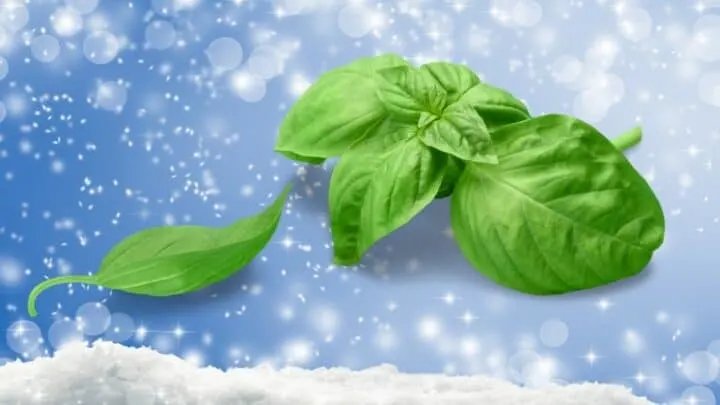Basil is an annual herb that is very popular for its variety of culinary uses. Native to southern Europe and Asia, this plant thrives in warm, sunny weather.
Basil is a member of the mint family (Lamiaceae) and is relatively easy to grow. If well-tended to, it will produce an abundance of fragrant leaves to cook with.
Table of Contents
How cold can basil tolerate?
Basil is very sensitive to cold temperatures. It will quickly show signs of damage, or even die off, when temperatures dip. Basil is the most healthy and productive at temperatures of 80 to 90 degrees F (27 to 32 degrees C). Chilly weather below 50 degrees F (10 degrees C) will begin to stunt the health of your basil. Once temperatures hit freezing (32 degrees F or 0 degrees C), your basil isn’t likely to survive for long.
The growing season of basil
Basil is an ideal plant to grow during the heat of summer and isn’t meant to last over the chilly winter season.
The normal life cycle of basil means the plant will die in the winter and drop its seeds. In the springtime, those dropped seeds will germinate and grow into a new plant.
If you’re planning to grow basil outdoors, the safest practice is to start your seeds indoors in the spring. That way, you can get a jumpstart on the growing season without the risk of freezing your seedlings.
Once outside temperatures consistently remain about 50 degrees F, it’s safe to transfer your seedlings outdoors.
If you live in a region that gets plenty of sun and stays warm year-round, your basil could survive the winter.
How to prevent cold damage on basil
You shouldn’t attempt to grow basil outdoors during cold weather, but sometimes late spring and early fall bring unexpected frosty temperatures.
Basil can survive outside for brief periods of cold as long as you take proper precautions, and temperatures don’t hit freezing.
Covering your basil plant is a good way to protect it from the elements and lock in warmth. Just make sure to remove the covering as soon as temperatures rise again to prevent overheating.
You can also add mulch around the base of your basil plant to add a layer of insulation. Mulching is great for your basil year-round since it helps maintain moisture and reduce weeds.
Bringing your basil plant inside is another good option to protect it from cold weather. You’ll want to do this if temperatures are going to remain chilly longer than a day or will dip to freezing.
Basil makes a great houseplant. Plus, bringing your potted basil plant indoors can extend its life over the fall and winter.
Lastly, if you’re planning to harvest the leaves on your plant for cooking, it’s best to do so before the risk of frost and damage to the plant. Fresh basil leaves can be frozen or dried for later use.
The symptoms of cold damage on basil
Excessive exposure to cold temperatures can kill basil, so it’s important to be aware of the signs of cold damage. You’ll need to take precautions to keep the damage from spreading further.
Cool weather (around 50 degrees F) isn’t likely to kill your basil, but it will cause the plant to grow more slowly and produce fewer leaves.
If your basil has been exposed to even colder weather, check the leaves for brown or black spots, wilting, or curling. These are all signs of cold damage and should be treated quickly to ensure the survival of your plant.
Don’t forget to check your indoor basil plants for damage too. While cold damage most often occurs outdoors, it can also happen inside.
You’ll want to keep your indoor basil near a sunny window since they like full sunlight. However, you should avoid drafty windows or letting the leaves directly touch a cold window as this can lead to damage.
How to treat cold damage on basil
Unfortunately, your basil plant isn’t likely to survive if it has been extensively damaged by frosty weather. If damage is only limited to small portions of the plant, pruning those sections away can save it.
Before pruning your plant, just make sure to take preventative measures so the plant isn’t exposed to further damage.
You may be able to save your plant for a while longer, but remember that basil plants won’t last forever. Since it’s considered an annual, basil only lasts for about a year before eventually flowering and dying.
Frequently asked questions on basil with regards to cold weather
What should I use to cover my basil plant in cold weather?
Cover your basil plant with a lightweight blanket, plastic sheet, or large bucket. Keep the basil leaves from directly touching the covering, which can cause cold damage.
How do I prune the cold-damaged leaves?
Make sure to use clean scissors or pruning shears to prevent the spread of disease. Cut away only the damaged leaves, leaving behind as much healthy growth as possible.

Daniel has been a plant enthusiast for over 20 years. He owns hundreds of houseplants and prepares for the chili growing seasons yearly with great anticipation. His favorite plants are plant species in the Araceae family, such as Monstera, Philodendron, and Anthurium. He also loves gardening and is growing hot peppers, tomatoes, and many more vegetables.


